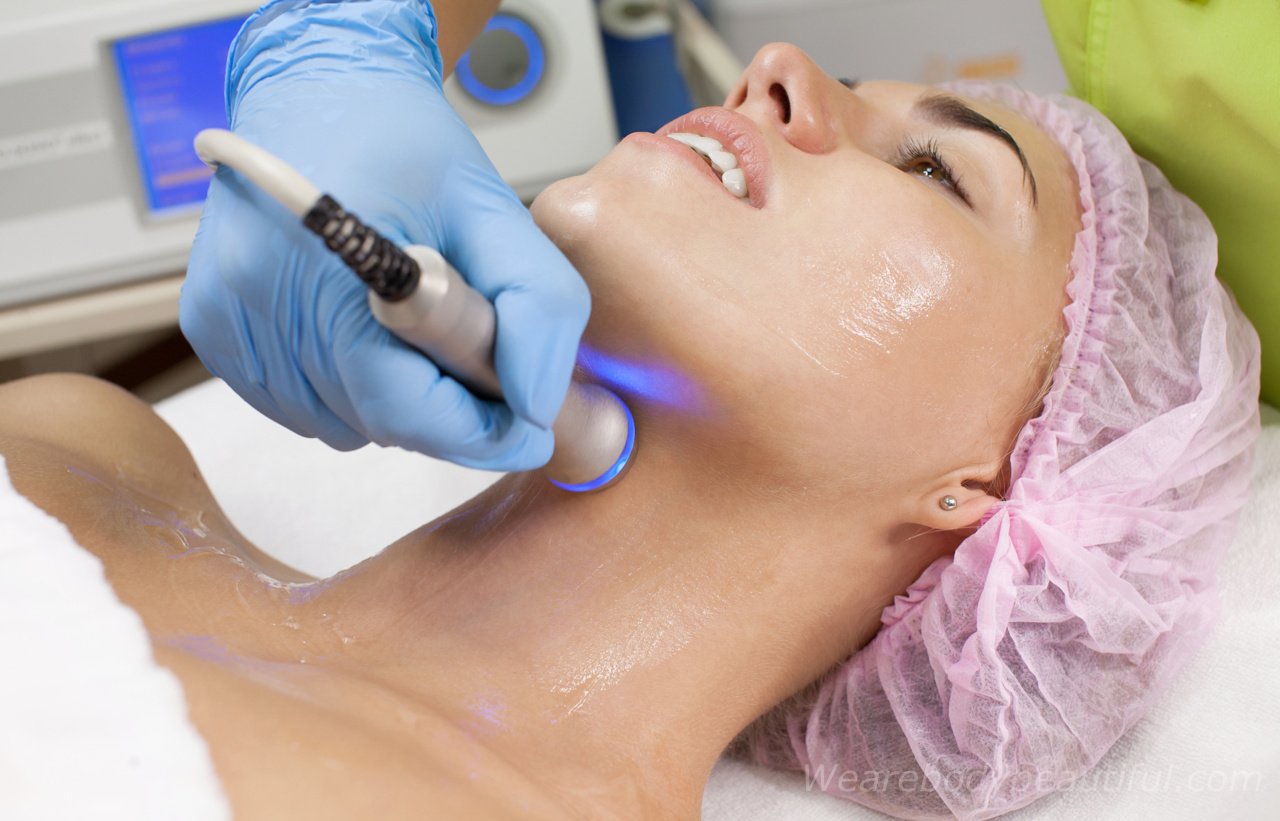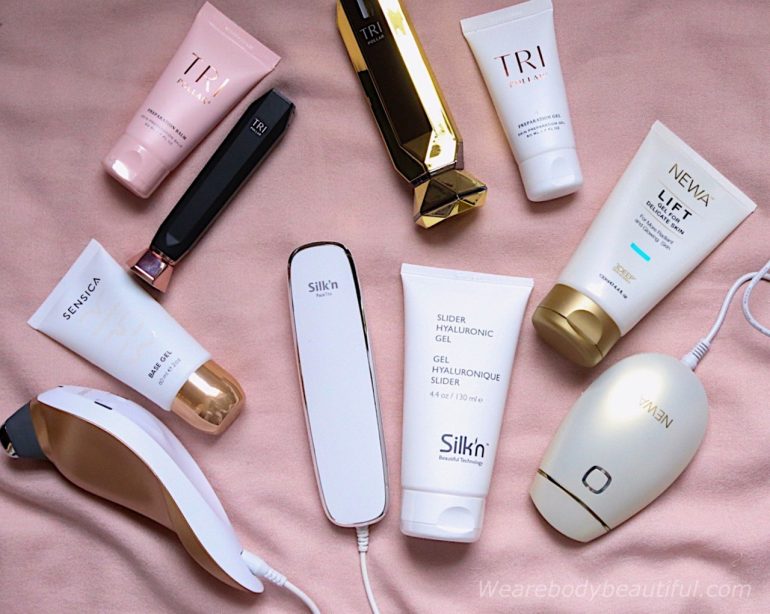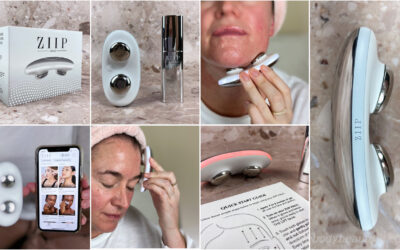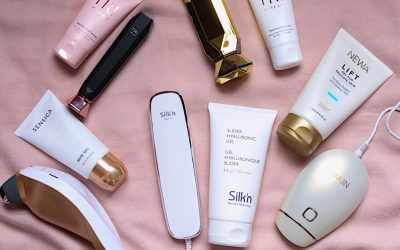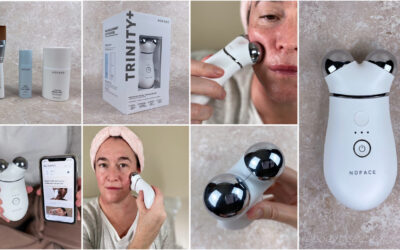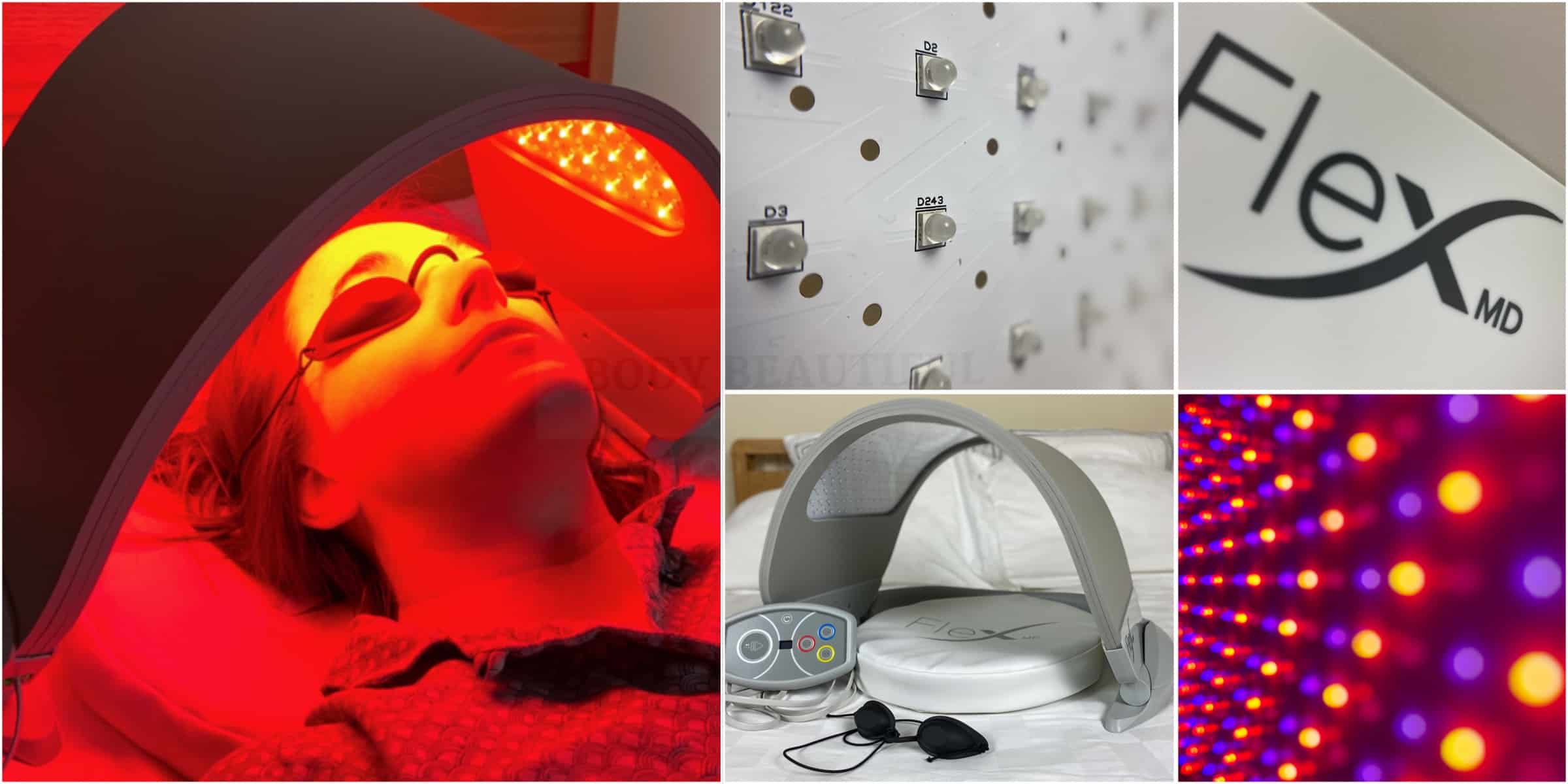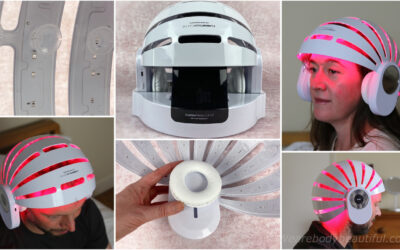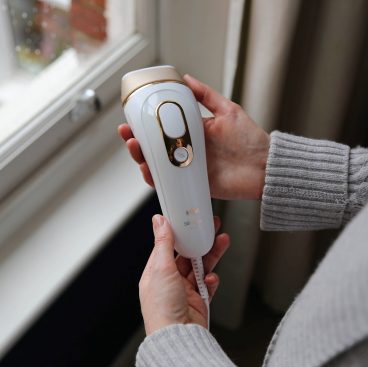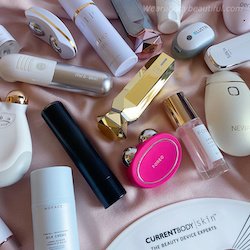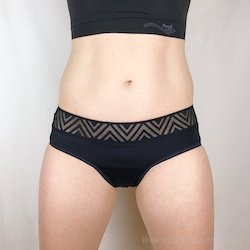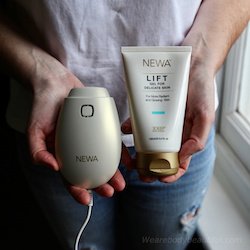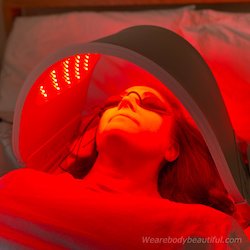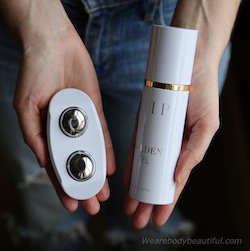T here’s some seriously sci-fi sounding home anti-aging technology available today. You can use oxygen or light of different colours and teeny electrical currents to stimulate your skin cells. Or there’s ultrasound to get more product deeper into your skin. But the most intriguing? It’s surely radio frequency.
But how the schnauzer can radio make you look younger?
It’s not as crazy as it sounds. A Radio Frequency device sends an electrical current into your skin. This heats your tissues causing an immediate tightening effect. It also kick-starts protein production. So, over time, you build fresh collagen and elastin fibres to support your face. The result is firmer, tighter, more radiant skin. Various home-use versions are available promising similar results.
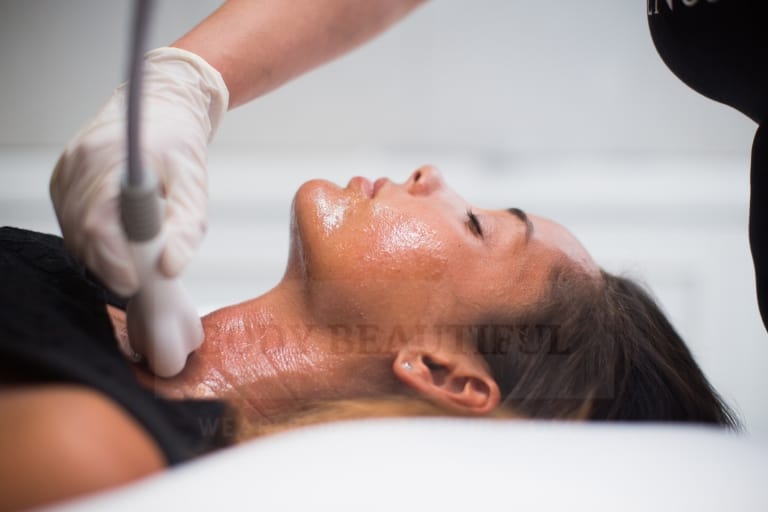
Now, you probably have many questions. I did too. So, off I set to learn all about Radio Frequency skin tightening and then share it with you.
What is Radio Frequency?
Radio Frequency (RF) is two things. First, it’s a type of electromagnetic radiation at a specific frequency range, also known as radio waves. And second, Radio Frequency also describes the oscillating electrical currents used to generate radio waves. Let’s look at each in turn.
#1 Radio Frequency is a type of electromagnetic radiation at a specific frequency range, also known as radio waves.
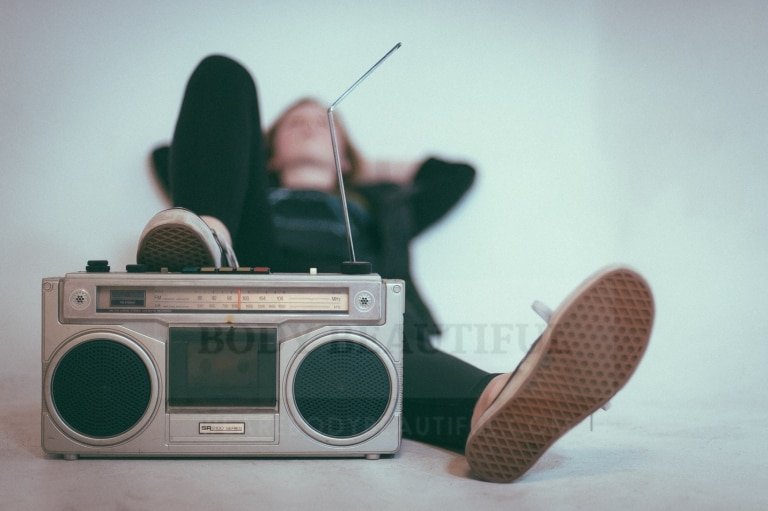
We’re surrounded by electromagnetic radiation. It comes from many sources including the sun, stars, lightning and our bodies. Gamma rays, X-rays, microwaves, lasers and light are other types. They span an enormous range of wavelengths and frequencies.
- A wavelength is the distance between two peaks of the wave.
- The frequency is how many cycles form in one second, and it’s measured in Hertz (Hz).
We categorise these different frequencies and wavelengths in the electromagnetic spectrum.
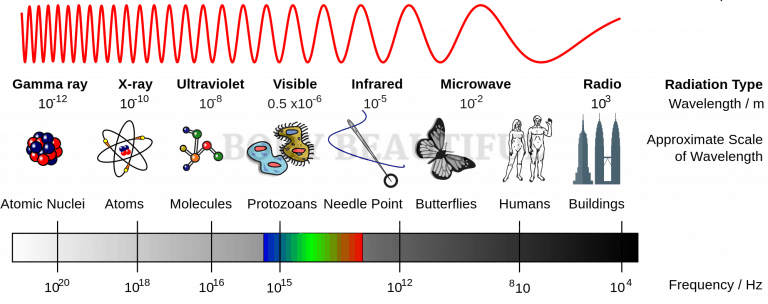
Radio Frequencies are the lowest energy electromagnetic radiation. They have a longer wavelength and therefore a lower frequency because each wave cycle takes longer to complete. The range of RF is around 20 kilohertz/kHz to around 300 gigahertz/GHz (30 billion hertz)2. But this isn’t exactly what we use in RF anti-aging skin tightening treatments.
#2 Radio Frequency also describes the oscillating electrical currents used to generate radio waves.
It works like this. Alternating currents of specific voltage sent through a conducting antenna vibrates electrons, generating radio waves. This is the transmitter. The radio waves travel at the speed of light from the transmitter to a receiver. Electrons in the receiver then vibrate, recreating the original signal. Learn more here.
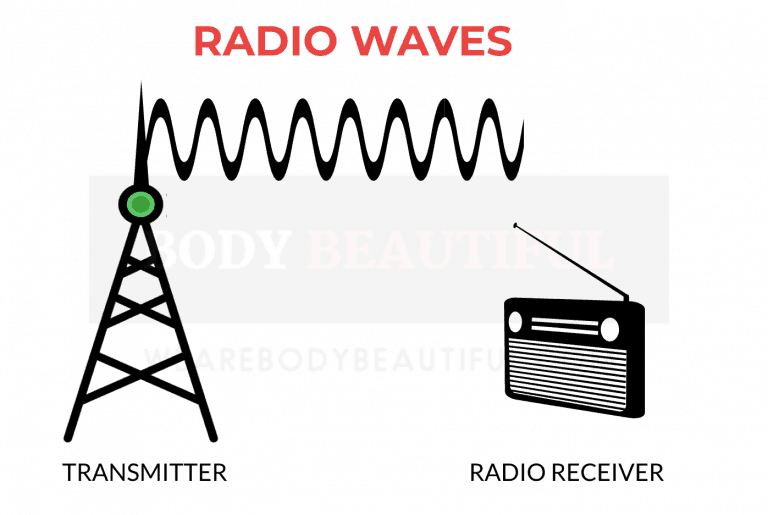
We divide radio frequency into bands, from very low to very high. Very low frequencies transmit longer distances, between 10-33km. So, we use these radio waves mainly for communicating voice, data and entertainment media. High frequency transmits just a little distance. And so it’s this RF generating electrical current we use to help the human body in medicine and aesthetics.
Radio Frequency current & the body

Unlike other forms of electrical current, RF currents flow through our tissues without shocking us. Here’s why.
Our nerve membranes have an electrical charge of their own. Any outside source of electricity affects them. An electric shock causes a sensation of pain and makes our muscles twitch. But an RF current is too rapid to do this. It travels at the speed of light, so our nerves and muscles don’t register it.
So then, what effect does RF current have?
How Radio Frequency current affects our tissues
Our cells conduct RF current in the range 0.3– 10 Megahertz (MHz) using it as part of their own electrical circuit. It flows freely through the tissues. But where there’s any resistance, it generates heat. And the heat produced depends on the electrical properties of the specific tissue.
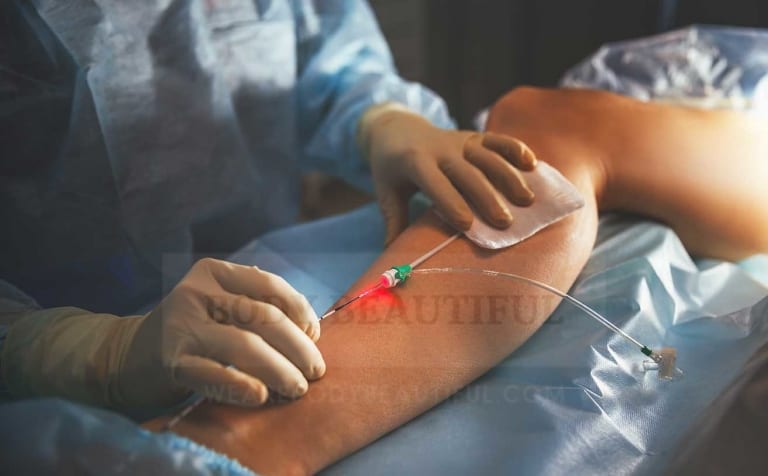
This means we’ve found several uses for it. For example, doctors direct RF current using the heat to destroy small tumours, varicose veins and even correct heart murmurs. Clinical studies confirm this technology is safe and effective.
It’s this same idea of heating tissue we use in anti-aging RF facials and body contouring.
How RF skin tightening works
To understand more we’ll first look at what happens in aging skin, and then how RF facials and body contouring help.
How skin ages
Below your skin’s surface, there’s a collagen and elastin scaffolding holding together the dermis and epidermis. This keeps your skin firm and bouncy. From age 30 onwards, we lose around 1 to 2% of our collagen every year. So, gradually this scaffolding becomes weaker and breaks down. Yikes. Also, the amount of collagen and elastin our fibroblasts produce decreases dramatically. And to top it off, the cells in our epidermis (skin surface) don’t renew as quickly either.
The result is sagging, textural issues, dullness and wrinkles. Oh, crapsticks.
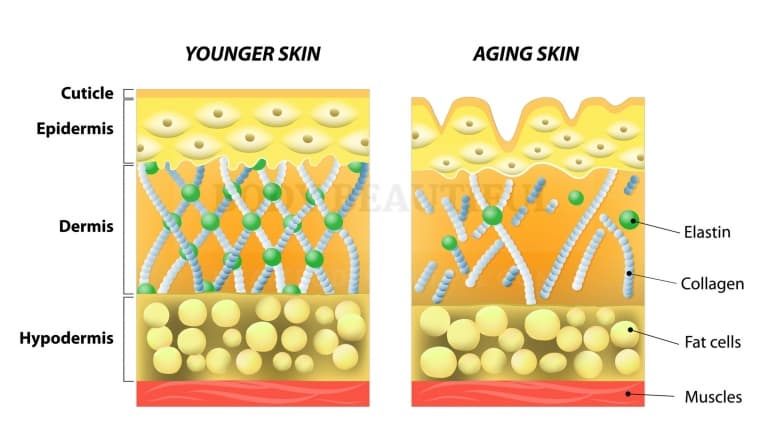
Now, there are different flavours of RF treatment to help combat these signs of aging.
Fractional RF is like a fractional non-ablative laser which heats tiny segments of the skin surface and dermis causing micro-injuries. Your skin’s healing response kicks in, rebuilding the damaged tissue. This resurfacing helps with fine lines, wrinkles, and improves texture and colour.
But there’s a deeper type of RF treatment, which we’re interested in. It concentrates on the lower skin layers. Along with microcurrent facials, this type of technology can lift, tighten and define facial contours.
So, let’s next look at how it does it.
RF skin tightening, dermal remodelling & increased metabolism
There are three important effects of RF treatments;
- skin tightening,
- dermal remodelling,
- and increased cell metabolism.
The RF heats and stimulates the underlying structures of the skin down to the dermis, causing controlled damage. Heating deeper skin tissues to 67°C gives the best results.
The heat denatures the collagen and elastin proteins. Denaturing means they unravel. Now, whilst this sounds bad, the immediate effect is the collagen matrix contracts and shrinks, creating a lifting effect of the face and tightening lax skin on the body. And this skin tightening is good because it gives a more youthful appearance.
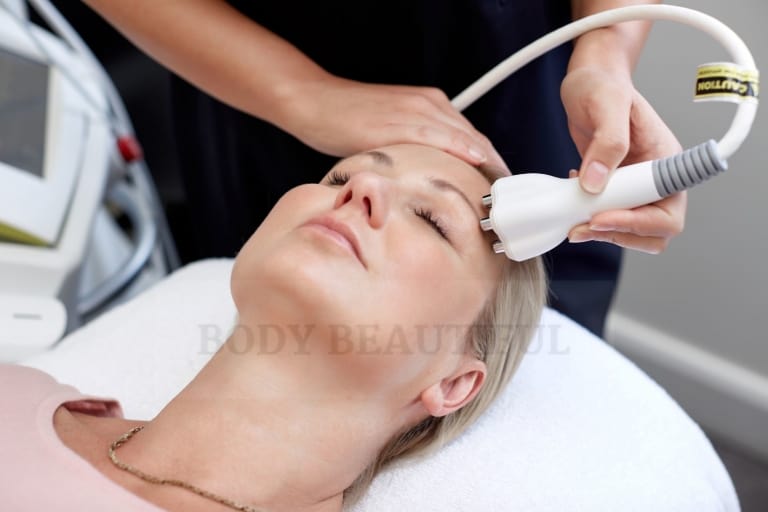
Your body then goes into healing mode, just as it does after a cut or injury. It triggers your fibroblast cells in the deeper skin layers to produce shiny new collagen and elastin. Over time, they create much more of these proteins than were there before. This tightening and increase in these fresh, supple skin-supporting proteins is dermal remodelling. It increases skin elasticity, reduces wrinkles and lines, tightens and firms, and improves skin texture and plumpness.
Heat also has a detoxifying effect and increases cell metabolism. That’s because when RF energy heats tissues between 40°C to 45°C, it increases blood flow through vasodilation. Vasodilation is the widening of blood vessels. The increased circulation brings more oxygen and nutrients to the cells. It also removes waste products, such as carbon dioxide. This means your cells’ metabolism speeds up resulting in more energy, so they work harder. This promotes skin health and gives an energy boost to fuel dermal remodelling.
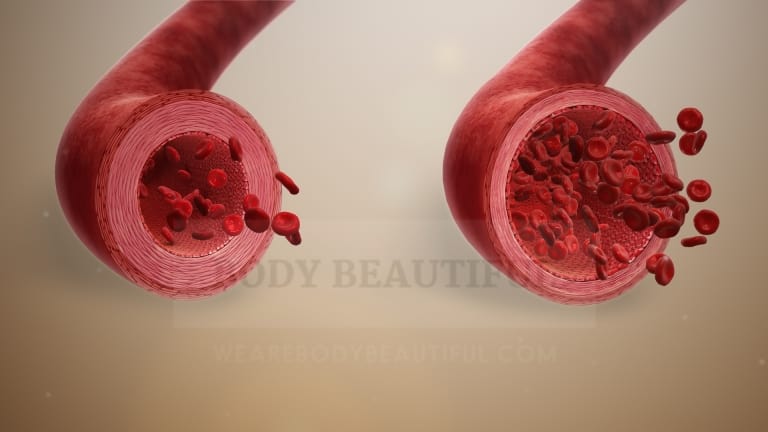
TIP: RF current doesn’t affect the melanin in your skin, so it’s suitable for all skin tones and types, without risk of discolouration. 13
These effects of RF give excellent tightening and anti-aging results on the face. And it works just as well on the body too. It’s particularly helpful for tightening loose skin after weight loss, pregnancy or from the natural aging process. We call this body contouring.
Radio Frequency body contouring
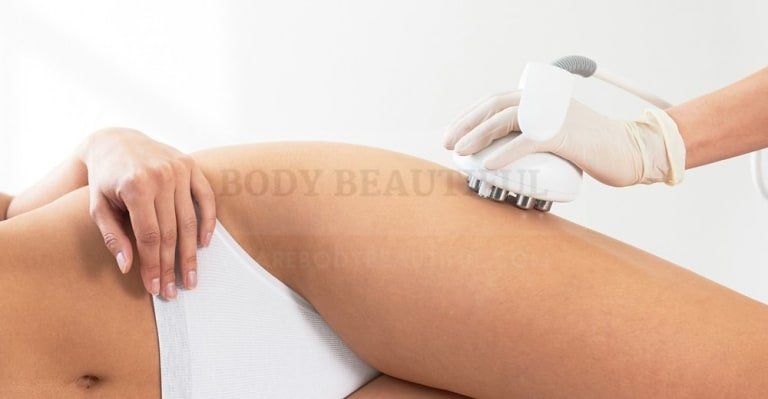
Non-surgical RF body contouring is a professional treatment that helps with common problems such as skin sagging on tummy, chest and knees, cellulite and reducing localised fat. It helps improve the appearance of saddlebags, inner thighs, love handles, abdominal fat, post-baby tummies and bingo wings.
You can choose to both reduce fat and then tighten the leftover lax skin, or simply tighten and remodel aging skin on the body.
For fat reduction, RF reaches down to the deepest layers of the skin to the adipose tissue. It heats only the fat cells causing apoptosis or ‘suicide’ of the fat adipocytes cells. Therefore, fatty deposits reduce in size for a slimming effect. Alternatively, machines may use ultrasound cavitation to target fat, exciting and bursting the fat cells. Fatty waste is then excreted through your lymphatic system.
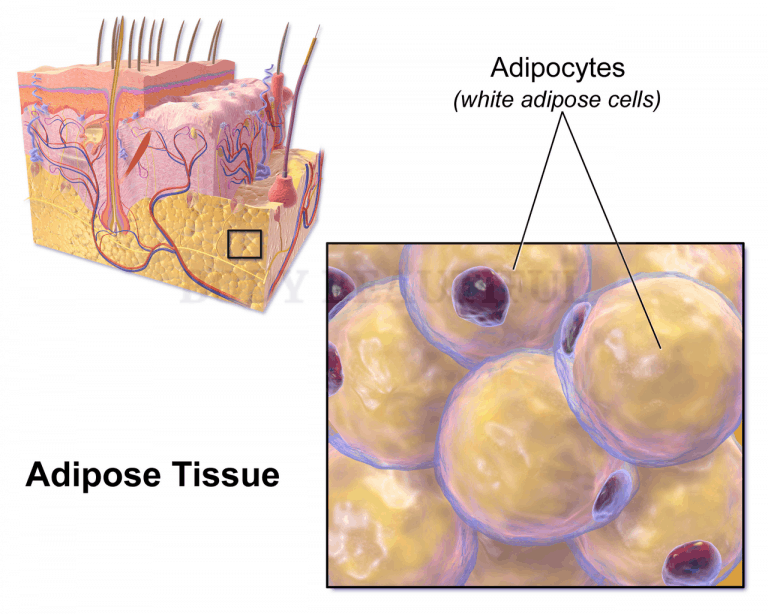
To tighten loose skin around your body, RF energy heats tissues in the dermis. As with RF facials, this causes the breakdown of collagen fibres for skin tightening, stimulates fibroblast production of collagen and elastin for dermal remodeling, and boosts cell metabolism.
The result is an improved body contour, with smooth, firm and luminous skin.
Surgical RF body skin tightening is a more extensive procedure done in the operating room under anaesthesia. The surgeon inserts an RF probe below the skin for an intensive application of RF heat to the subdermal layers, whilst infrared cameras monitor the skin temperature. This procedure focuses on tightening loose skin on the arms, legs, stomach, back, and buttocks.
There are also two ways to deliver RF energy; monopolar and bipolar.
Different types of RF
There are two ways that we can direct RF into the skin: monopolar or bipolar.
Monopolar is most common in professional body contouring. It’s also known as unipolar because the instrument has one electrode/pole in the handpiece. This RF delivery treats deep tissue structures because the positive and negative poles are separate from each other. It works like this:
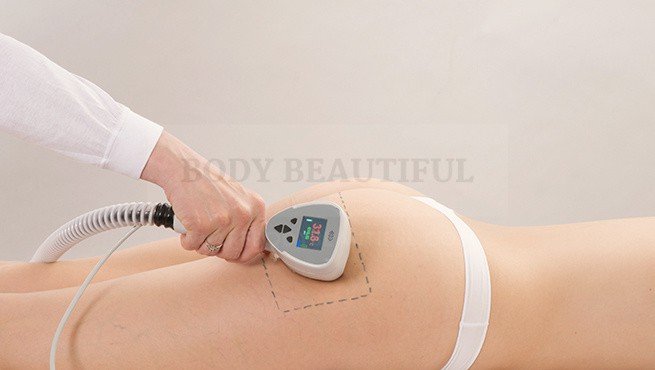
The unit generates the current, and the handpiece applies the positive RF current to the skin. Most resistance occurs where the handpiece touches the skin.
Attached to the client, usually on their lower back, is a negative grounding pad. The pad creates a low resistance path for the current to return to the generator, completing the electrical circuit. The RF current travels from the handpiece to the pad, passing through all the skin layers. It even reaches the subcutaneous fat layer 20mm below the skin.
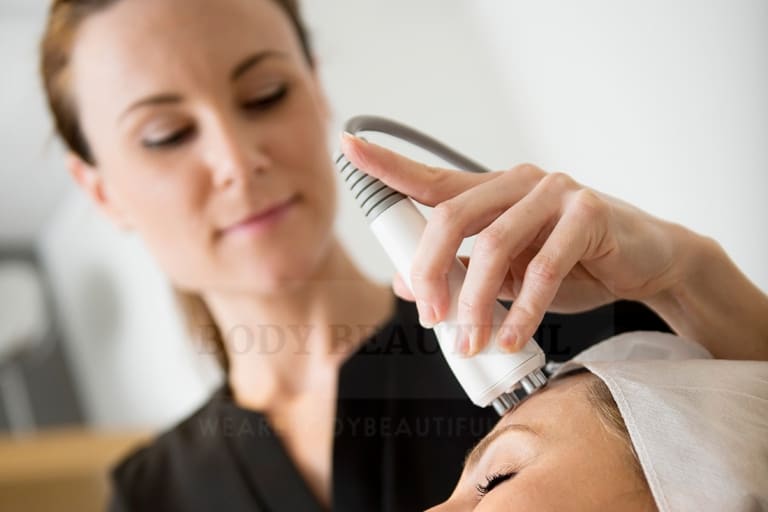
Bipolar means the handpiece has poles in sets of two; negative and positive. It’s used in both professional RF facials and at-home devices.
The RF current flows only through the small area of tissue between these two poles, reaching 2-4mm below the skin. The current doesn’t flow through the deep tissues.
Tri-polar machines can deliver both types of RF treatment.
Can I have RF treatments?
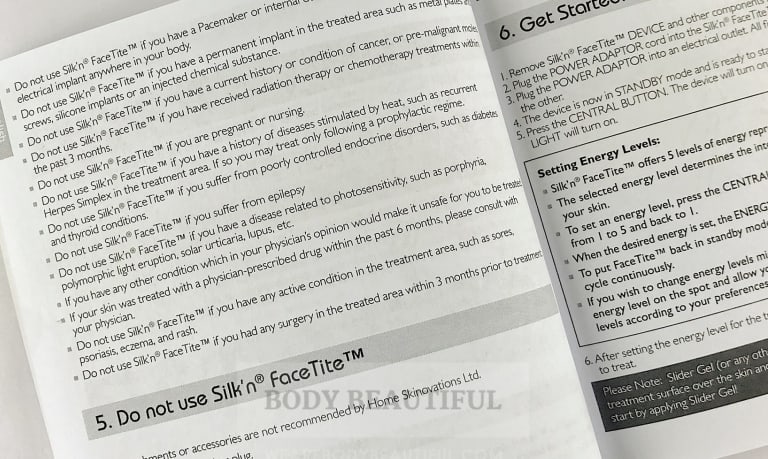
RF is safe, but if you have certain conditions you must avoid it. A professional operative will check your medical history. But at-home, you must check your device’s user manual thoroughly. It’s a good idea to download a copy and read it before you buy. Most brands have a PDF version available on their websites. If not, email their support team and request a copy.
Here are the contraindications applying to both professional and at-home Radio Frequency skin tightening.

Key checks ✔️
You CAN’T have RF sessions if you:
- Are under 18 years of age
- Are pregnant or are nursing
- Have a pacemaker or defibrillator
- Have metal implants in the treatment area, such as gold threads or metal plates & screws. But dental fillings or implants are ok
- Currently use medications, herbal preparations, vitamins or food supplements that may cause fragile or dry skin

Body areas to avoid ❌
DON’T USE a home device on the following areas:
- over eyelids,
- closed eyes,
- thyroid area,
- lips,
- ears,
- breasts
- or genital areas
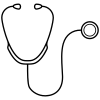
Medical History
DON’T USE if you currently have, or have a medical history of:
- Cancer, especially skin cancer or premalignant moles
- Severe concurrent conditions, such as cardiac disorders
- An impaired immune system due to immunosuppressive diseases such as HIV, or are using immunosuppressive medications
- Heat-stimulated diseases such as recurrent Herpes Simplex (within the treatment area)
- Any active skin condition within the treatment area, such as sores, psoriasis, eczema or a rash
- Keloid scarring, abnormal wound healing or fragile skin
- Suspicious lesions within the treatment area
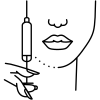
Cosmetic or surgical procedures
DON’T USE if you’ve had these recent cosmetic or surgical procedures:
- Any surgical procedure, laser resurfacing or deep chemical peeling in the treatment area within the past three months or are still undergoing a healing process
- Permanent fillers within the treatment area.
- If you have temporary dermal fillers within the treatment area, consult your doctor for advice
- Collagen or Botox administered in the treatment area within the past three months

Professional RF skin tightening only
These apply to professional RF treatments.
DON’T USE:
- If you have a history of coagulopathies or the use of anticoagulants
- Have used isotretinoin in the past 6 months
- Taken nonsteroidal anti-inflammatory drugs (e.g. with ibuprofen) one week before and after each treatment
- On a tattoo or permanent makeup
- On excessively sunburned skins, tans from sunbeds or tanning creams in the last two weeks
Preparation for RF skin tightening
The Harley Medical group suggest a few helpful preparation tips for professional face and body skin tightening treatments.
DO ✔️
- Avoid the sun for 2-3 days before so your skin isn’t dry or red
- Remove make-up prior to facial treatments
- Drink 1 litre of water in the few hours before your session. Keep well hydrated
- Eat light food before your session
- Wear loose fitting and comfortable clothing for body skin tightening
DON’T ❌
- Apply fake tan or tanning creams within 10 days of the treatment or throughout the treatment course
- Don’t apply creams or oils to your skin before your session
- Avoid heavy meals that are carbohydrate or fat rich less than two hours prior to your treatment
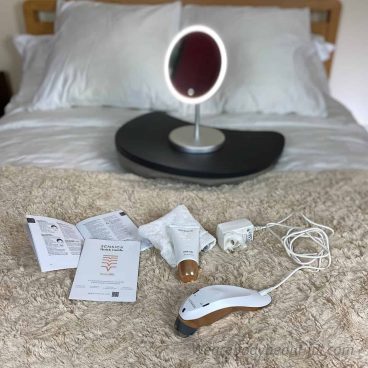
FOR AT-HOME SESSIONS ✔️
- Wash and dry your face
- Find a comfy and warm spot, I like to sit on my bed
- Watch TV, listen to music or a podcast
- Use an extension cable so you’ve plenty of slack
- Have a small, portable mirror handy
- Don’t forget to apply a thin layer of RF gel!
- Use your phone to time each section
- Tie your hair back so it doesn’t get stuck in the gel
- Have a towel handy to clean up any gel slops
TIP: If your body is cold it takes ages to get your skin to temperature. So, it can feel like it’s not working. I like to do my treatments after I’ve taken a shower. This makes sure I’m nice and warm, plus I feel nice and relaxed for my session!
What does it feel like?
If you opt for a professional RF facial, your clinic will advise which facial areas they’ll focus on. Common areas are the forehead, under the eyes, cheeks, mid-face, jaw line, and neck.
Your clinician will talk you through what happens, what results to expect, and post-treatment care typically lasting around a week after your session. For example:
DO ✔️
- Drink 4 to 5 glasses of water each day
- use sun protection cream
DON’T ❌
- sunbathe, or use a sauna, and no hot baths!
- drink alcohol (for at least 2 days)
For the procedure, you’ll lie on a treatment bed with the RF machine next to you. Most machines are a large base unit with controls, and gunshaped hand-pieces connected by cords. The clinician first applies a conductivity gel to the treatment areas. They then move the RF probes on your skin, in upward and circular motions. As they move along your skin you’ll feel warmth, and also occassional cooling. The clinician adjusts the RF intensity to match your skin sensitvity, and they monitor your skin temperature to avoid overheating. It shouldn’t be painful or too hot, but it’s important to say if it’s burning or uncomfortable!
⏱ A professional session focusing on your under-chin, neck, jawline, cheekbones and forehead takes around 50 to 60 minutes.
For at-home sessions, you divide your face and neck into sections and work on each in turn. First apply the protective conductivity gel. If it’s water-based, apply it to one section only in turn. The gylcerin based gels don’t dry out so you can apply them to the whole of your face. Then, slowly glide the electrodes in small overlapping circles all over the treatment area. Repeat for around 4 to 5 mins per area.
The Tripollar Stop VX is my favourite at-home RF device for full-face and neck, and the NEWA is awesome for your cheeks, jaw and chin area.
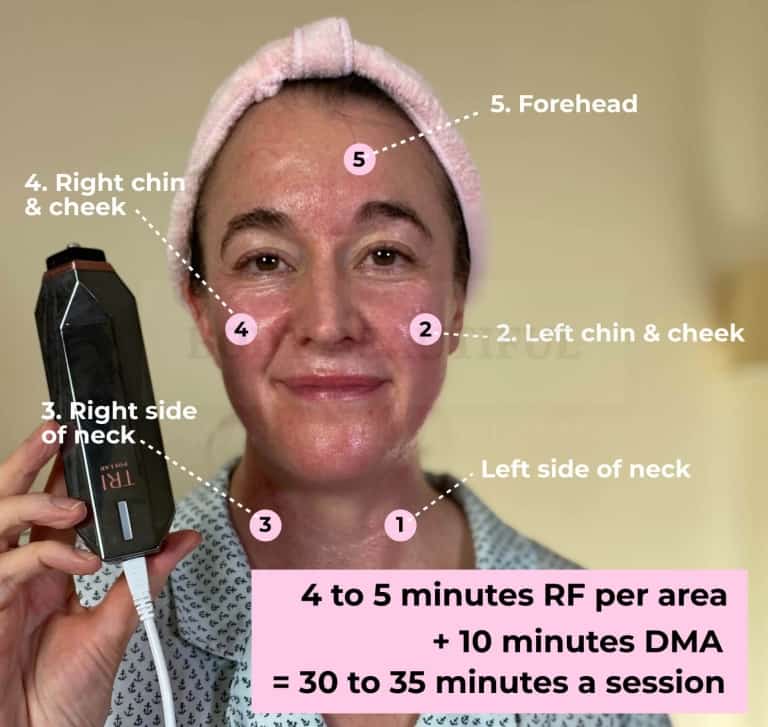
You feel pleasant heat slowly building. Keep the electrodes moving or it gets burny hot very quickly. Most devices have skin temperature sensors and switch the RF off when the skin reaches the perfect temperature. And some devices feel hotter than others. A full face and neck session takes from 25 to around 60 minutes, depending on your chosen device.
Once you’re done, wipe or wash off the gel. Then apply your favourite nourishing and hydrating serums and creams. I opt for hyaluronic acid rich products, sealed in with a ceramide based moisturiser. If you have the time, a moisturising sheet mask is a delicious alternative treat too.
Radio Frequency possible side effects
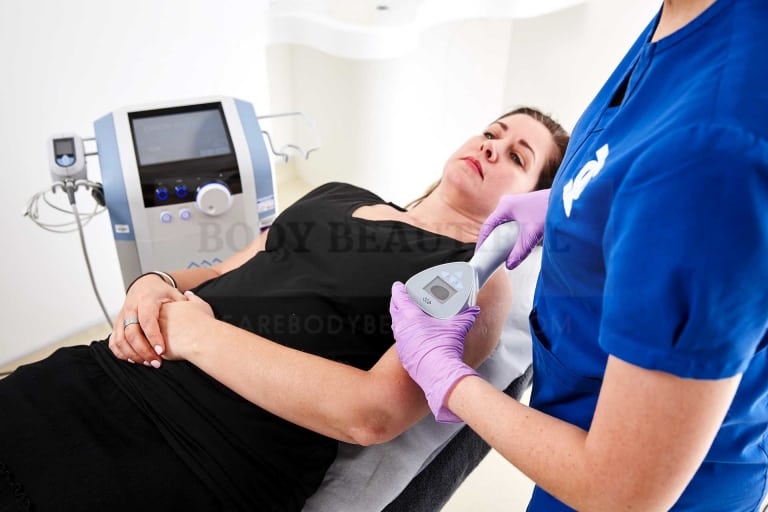
RF treatments are very safe and well tolerated. Common skin reactions to the heat are red and swollen or plumped skin. Use Aloe Vera to cool and soothe if necessary.
There are a few rare and temporary side effects with professional and at-home RF skin tightening. If you get any and they last more than 24 hours, go see your doctor.
- Pain
- Damage to natural skin texture (crusting, blistering, burns, fragile skin, bruising)
- Mild headache
You should also avoid sun exposure after a session and always wear a good sunscreen! Make sure you moisturise well after a session to avoid any skin drying too.
Schedule & results for RF skin tightening
The advertised effects of a professional skin tightening RF treatment on body or face are:
✔️ Short term collagen shrinkage in the dermis
✔️ Longer term fibroblast stimulation to create revitalised collagen and elastin
✔️ Stronger skin scaffolding in the deeper skin layers
✔️ Enhanced cell metabolism
✔️ Refreshed epidermis/outer layer skin cells
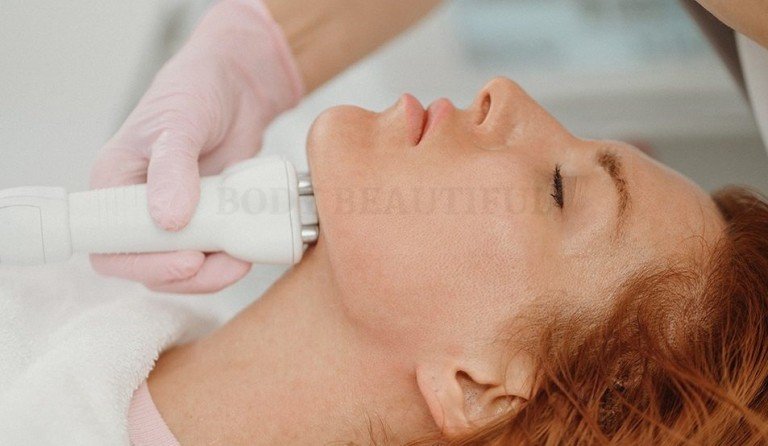
You need a course of 3 to 8 treatments, but typically around 6 professional RF treatments. You may see some immediate tightening after each session. But results appear gradually over several months. Best results are typically at the end of the schedule. However, you may see further improvements over the following 3 to 6 months. That’s because your skin is still building shed loads of collagen and elastin. Top-ups are recommended every 1 to 3 months, depending on your end results.
The Harley Medical Group say skin tightening effects vary and are different by individual, so they can’t guarantee specific results. Therefore, they can range from subtle to significant, and last months to years. Results are:
- Tightening of lax skin such as jowls, eyebrows and neck
- Reduces pore size, fine lines and wrinkles
- Smoother skin texture
- Healthier looking, radiant skin
The effects of at-home RF skin tightening are similar to professional sessions. However, the effect of each session is much reduced. Therefore, you need many more treatments, several times per week during a start-up stage of 4 to 8 weeks.
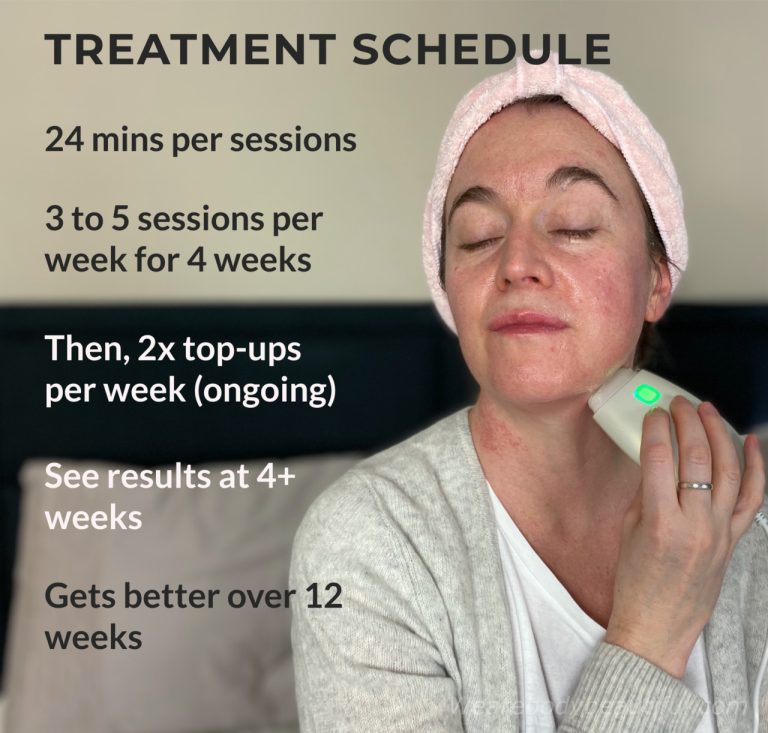
Results are also gradual, and best at the end of the course, further developing over the next few months. They vary by individual too. Stick with the top-ups, typically one or two per week, to maintain your results.
Reassuringly, there are clinical studies proving Radio Frequency skin tightening works too.
Clinical proof
Numerous clinical studies show that RF is effective at skin tightening. There’s lots of proof it works.
In 2011, researchers in the USA studied six participants and found the RF produced noticeable clinical results. The subjects were also highly satisfied with their skin improvement and increase in collagen.
Researchers in Korea mirrored these findings. RF treatment is safe and effective to treat signs of ageing and reducing scarring.
However, such studies researching the effects of aesthetic rather than medical treatments are difficult to compare. That’s because they use small groups of people, and the methods and research quality vary significantly. Brazilian researchers discovered these issues in their literature review of 2015. They looked at 30 different studies investigating RF facial treatments. They conclude whilst RF therapy is successful in stimulating collagen synthesis, we need further studies to clarify treatment parameters and effectiveness.
At-home bipolar devices are not as powerful as professional monopolar devices. However, researchers have shown they are effective in some clinical trials.
Professional RF vs at-home
Like most at-home and professional comparisons, you can expect faster results with professional sessions. But you’ll also pay a lot more overall.
Here’s a comparison table to show the key similarities and differences.
| Professional RF skin tightening | At-home RF skin tightening | |
|---|---|---|
| Who’s it for? | ✔️ For men and women ✔️ Safe for all skin tones and types. |
✔️ For men and women ✔️ Safe for all skin tones and types. |
| What skin types? | 👉 For jowls and loose skin on the jawline and neck 👉 Fine to medium lines around eyes 🧑⚕️ Your practitioner advises the number of sessions best for your skin condition and the likely outcome. |
👉 For lax facial skin 👉 Lines and wrinkles Follow the recommended treatment schedule. |
| Schedule | 🗓 Around 6 sessions, each session 1 to 2 weeks apart. | 🗓 2 to 3 sessions per week, for 6 to 8 weeks |
| Maintenance | Top-ups every 1 to 3 months, depending on your results and skin type. | 2 to 4 top-up sessions per month |
| Preparation | ✔️ Cleanse and remove make-up ✔️ Drink plenty of water before and after your treatments No anaesthetic required |
✔️ Cleanse and remove make-up ✔️ Drink plenty of water before and after your treatments. |
| Session | Operative applies conductivity gel and massages the applicator is slow continuous movements gradually heating your face and neck. | Apply conductive gel to your treatment area, and working in small zones, move the electrodes over your skin gradually heating it until the time is up. Move onto the next area until all desired zones are complete. |
| How long is a session? | ⏱ Usually 30 to 60 minutes Sometime combined with other treatments such as vacuum massage. |
⏱Around 1 hour per full face session. |
| Sensation | Operative applies conductivity gel and massages the applicator is slow continuous movements, gradually heating your face and neck. | Apply conductive gel to your treatment area, and working in small zones, move the electrodes over your skin gradually heating it until the time is up. Move onto the next area until all desired zones are complete. |
| Sensation | Relaxing & pain free, warm massage sensation Some swelling and redness possible afterwards on the skin, normally lasting just a few hours. | Relaxing & pain free, warm massage sensation Some redness afterwards on the skin, usually fading within an hour or two. |
| Side effects? | Very rare side effects. Pain Damage (crusting, blistering, burns, fragile skin, bruising) Mild headache |
Very rare side effects. Temporary swelling Redness Tingling |
| Contraindications | RF treatments are generally safe with no down-time. However, there are some reasons you may not be suitable. See the contraindications listed above. |
See the contraindications listed above. |
| Cost | Single session £65 to £140 Course of 6 £375 to £680 |
From £99 to £649 for a home-use RF device. Some combine with other anti-aging technologies. |
| Results | Tighter, firmer & younger looking skin with improved skin tone, texture & elasticity. Fine lines on the face disappear and soften deeper wrinkles. | Tighter, firmer & younger looking skin with improved skin tone, texture & elasticity. Reduces the appearance of fine lines & wrinkles. |
| Pros & Cons | ✔️ Results are usually more significant than home-use devices ❌ Results don’t last forever and you need regular maintenance sessions ❌ User reviews suggest results vary & they aren't guaranteed |
✔️ Much more affordable than professional sessions ✔️ You can maintain results in your home with a reduced treatment schedule ❌ Results vary & you may not get the lift you desire ❌ They demand upfront & ongoing commitment & effort |
At-home Radio Frequency devices
If you have the dosh and want to splash out, you can try searching locally for a trusted beauty spa or clinic. Check the reviews, and ask about the equipment and training before you go ahead.
But if professional RF is out of your budget, you can try this instead…
The best at-home Radio Frequency round-up
Learn all the pros & cons of the best at-home Radio Frequency skin tightening devices to give you a tight, bright, smooth and plump skin with lifted sagging jowls, jaw and chin too.
Post References
- https://www.livescience.com/38169-electromagnetism.html
- https://en.wikipedia.org/wiki/Hertz
- https://www.explainthatstuff.com/antennas.html
- https://en.wikipedia.org/wiki/Radio_frequency
- https://www.researchgate.net/publication/283176782_Radiofrequency_in_Aesthetic_Medicine
- https://www.ncbi.nlm.nih.gov/pubmed/22407695
- https://www.ncbi.nlm.nih.gov/pmc/articles/PMC3583892/#R30
- https://www.ncbi.nlm.nih.gov/pubmed/1220811
- https://www.ncbi.nlm.nih.gov/pubmed/16723701
- https://www.ncbi.nlm.nih.gov/pmc/articles/PMC3036829/
- https://insights.ovid.com/article/00042728-201505000-00010
- https://www.ncbi.nlm.nih.gov/pubmed/14179628
- https://www.ncbi.nlm.nih.gov/pmc/articles/PMC2810682/
- https://www.jaad.org/article/S0190-9622(10)00760-7/fulltext
- https://en.wikipedia.org/wiki/Apoptosis
- https://en.wikipedia.org/wiki/Adipocyte
- https://www.youtube.com/watch?v=-lQrYJXVdu0
- https://www.jaad.org/article/S0190-9622(10)00760-7/fulltext
- http://www.jkslms.or.kr/journal/view.html?uid=20&vmd=Full
- http://www.scielo.br/scielo.php?script=sci_arttext&pid=S0365-05962015000500707
- https://www.ncbi.nlm.nih.gov/pubmed/17941360

